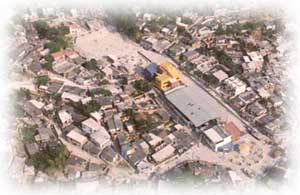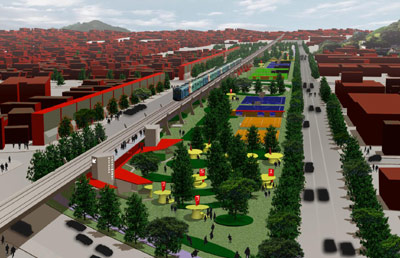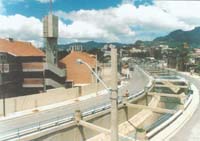| Favelas |
| My response to the Committeeof the Graduate School of Design (GSD) of the Harvard University |

Nucleous of Intervention
in Campinho
Before the announcement of the result of the Sixth Veronica Rudge Green Prize in Urban Design of the Harvard University, Graduate School of Design (GSD), the sites of urbanization in the "favelas", developed by the architect Jorge Mario Jáuregui, had been visited by a commission, that asked questions related with the concepts that based the projects.
Below are some of them.
Question - What is the difference between Modern Urbanism and your work, which also aims to change people's standart of living, creating a better environment for social evolution?
Response
- Modern Urbanism implied "Tabula rasa", started from the
"clearing" of the area, where the "creation" of the
new controlled environment would take place, which would condition new
social relationships (Hillberseimer, Le Corbusier, Lucio Costa, etc.)
Their social effects were unpredictable.
The physical aspects were the "cause".
Nowadays, we start from the "existences" (what is already there),
from established relationships (uses) between the physical conditions
and a determined social organization. Therefore, there is a structure,
there is a previous history of land occupation that cannot be ignored,
that needs to have its logic interpreted, and consequently, tries to potentialize
the interaction between these two factors.
At present, existing social relationships constitute the basis for proposals
on structured urbanism ; an inversion of the situation.
The physical aspects are the consequence.
This is the reason for the fundamental importance of the "scheme
of the reading of the structure of the place"; the interventions
are introduced in an existing "milieu", considered as a collective
construction.
The social effects can be now "oriented".Starting from the strengtening
of the "latent or manifest centrality", creating a new "attractor";
spreading a number of "centers" following a sinuous axle (Vidigal);
dispersing an excessive concentration in a number of small events (Salgueiro);
creating a new major center dislocating the importance of the previous
ones, but keeping their existence, no longer as "attractors"
but as attracted (satellites), Fernão Cardin, Macacos, etc.

Scheme
of reading of the structure of the place of Manguinhos
New approaches have emerged, diverging from what was established in Le
Corbusier's "Letter of Athens".
Modern Urbanism conceived the city as something derived from the relation
among the functions of habit, work and re-creation and their connections
(number 77 of the "Letter of Athens"), which constituted the key to "new
urbanism". According to the "Letter", the project (the
new one) would be the cause for new social relations, and it should impose
itself to the context.
A universal spirit gave rise to this search, and for this reason, there
was an attempt to apply it in every context indiscriminately. An optimistic
belief in urbanism and architecture as an antidote against the existing
"chaos", guided the proposals. Rationalist modern architecture was the
model to re-organize the cities, clean them and provide happiness to their
inhabitants.
Today, it is a general consensus that the wealth of urban life can't be
reduced to a functional scheme. An urban project is dependent on a pre-existent
web of social and physical relations. This is the reason why it should
be closely elaborated in relation with the previous existing conditions,
through an interaction with the community. We must begin with the reading
of the structure of each specific place to determine the project premises.
In this way, the project is conditioned by the pre-existent and, at the
same time, it re-signifies the place.

Perspective
of the metropolitan projected park in Manguinhos
The strategy of the actions is the careful search for a local balance in the center of contexts that are in permanent mutation. Today we think that there are not universal solutions, that each case has its own premises. Furthermore, urbanism and architecture must be conceived as having a close link with structural components related to the social, economic, environmental and cultural aspects. The inter-disciplinary collaboration coordinated by architect-urbanists should start from the moment that the projects are elaborated. This is the way that we have utilized to confront the complexity of the vast range of problems that must be faced. Today we think that the configuration of the physical mark of social life activities, is linked with the necessity of the citizen's participation concerned with the collective interest. On the contrary, it doesn't reduce the responsibility of Urban Design in any way.
The articulation of the social, economic and political determinations which confront as and the individual subjectivity of the designer, are closely tied together. They should also lead to a point of verification. Either the project works as a collective expression, or it doesn't work at all.
This is the specific challenge in the design field; to be capable of turning into a condensator of subjectivity, not only collective but also individual. In the given context in it is extremly important to make the design coincide with the intentions that are programmatically pointed.
Defining coherent Public Policies of Urbanistic and Social Development with possibilities to transform the state of things in a positive way, implies working simultaneously in two articulated levels:
-
Developing guidelines of Urban, Social and Economic Planning;
- Developing proposals of Urban Design for specific sectors capable of
acting as exemplary cases, aiming to induce desired transformations in
the shantytown and in its vicinity.
It involves a coordinated approach to all intervenient factors and the definition of specific methodologies.
This includes:
- Articulation between Strategic Planning and Urban Design;
- Definition of Urban Scheme ("Partido Urbanístico");
- Definition of legal adjustments and norms;
- Geological and environmental studies/prevision of catastrophes;
- Development of infrastructure projects;
- Articulation among Urbanistic and Architectural Projects, and Social
and
![]() Economic Policies;
Economic Policies;
- Social Communication/ Community participation;
- Aspects related with land tenure;
- Management of all actions.
Before

Fernão Cardin
Jorge Mario Jáuregui
